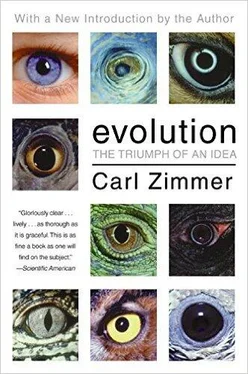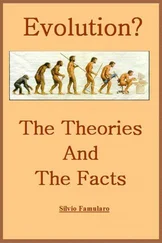A grassroots opposition to the denatured standards sprang up in Kansas. It gathered strength in the months that followed, and in the next round of school board elections in 2000 the creationist-leaning bloc suffered heavy losses. Two members (including Holloway) were defeated by moderate Republicans in the primary, and a third member resigned and was replaced with another moderate Republican. In February 2001 the board finally approved the original standards, with the teaching of evolution intact.
Creationists may have lost this round in Kansas, but they continue their political fight throughout the United States. In May 2000, Intelligent Design proponents were welcomed to Capitol Hill by conservative congressmen to describe their ideas. The Oklahoma legislature has passed a law declaring that biology textbooks must inform students that the universe was created by God. In Alabama, textbooks are pasted with warnings that evolution is a controversial theory, not a fact. In the spring of 2001 a bill was introduced in Louisiana preventing the state government from distributing false information such as radiometric dating.
These sorts of laws are not the only way to stop teachers from teaching evolution—intimidation works as well. In order to avoid controversy and stand-offs with some parents, high school biology teachers often shy away from Darwin. “I talk to teachers at science-teacher conferences and they tell me that their principal has told them just to skip evolution this year because it’s an election year, says Eugenie Scott, executive director of the National Center for Science Education. “There is a new school board coming on and they don’t want any problems. That is crazy. I mean, that is just not the way to run a coherent curriculum.”
Paying the Price
The result of these conflicts is not a new generation of creationists, but a generation of students who don’t understand evolution. This is a bad state of affairs, and not simply because the theory of evolution stands as one of the greatest scientific accomplishments of the past 200 years. Many careers that students might want to pursue actually depend on a solid understanding of evolution.
To search for oil and minerals, for example, you have to understand the history of life on Earth. For 4 billion years, species have evolved, given rise to new species, and become extinct. Their fossils can act as markers for rocks that were formed while they were alive. If geologists find some distinctive fossil plankton in a formation of rock that’s rich in oil, they know they may find oil somewhere else if they can find that same plankton again.
Evolution is even more important to biotechnology, because when researchers tinker with life itself, they have to deal with the fact that it evolves. The resistance that bacteria have to many antibiotics didn’t just happen: it unfolded according to the principles of natural selection, as the bacteria with the best genes for fighting the drugs prospered. Without understanding evolution, a researcher has little hope of figuring out how to create new drugs and determine how they should be administered.
The same goes for vaccines. As microbes evolve, they become isolated into genetically distinct populations, which create new branches on the evolutionary tree. A vaccine may work against one strain of a disease like AIDS, but fail against more common ones because they’re only distantly related. The evolutionary tree also tells scientists where diseases come from (in the case of AIDS, most likely chimps). That in turn can guide them to possible cures.
Evolution on its grandest scale can be just as crucial to business. Some of the biggest efforts in biotechnology these days are going into genome sequencing—decoding the complete sequence of our genetic code, as well as that of other life-forms such as bacteria, protozoa, insects, and worms. The money’s going in because big profits may come out. Scientists are studying the genes of fruit flies because humans have very similar genes. Experiments on the flies may someday lead to medical miracles such as extending the human life span. But scientists will first need to learn how that similarity evolved. Medicine, in other words, has its roots in the Cambrian explosion.
The same kinds of applications may also come from understanding how different species have fused together over time. Take malaria. This disease, which kills around 2 million people every year, defies the best efforts of modern medicine. Recently scientists have discovered that the parasite that causes malaria carries genes that come from algae. Perhaps a billion years ago, the ancestor of this parasite engulfed a species of algae. Instead of digesting it, it turned the algae into a symbiotic partner, and today some of the algae’s genes remain. This discovery may reveal a way to attack malaria. If the parasite has some algae-like qualities, the poisons that are known to kill plants might be able to kill it as well. Without an evolutionary framework, scientists would probably never have thought to try to destroy malaria with weed killers.
Biotechnology will keep speeding ahead, and it will keep relying on evolution as its central organizing principle. And it won’t wait for people who don’t understand how life evolves because someone else decided they didn’t need to.
In the Country of Asa Gray
When William Jennings Bryan waged his battle against evolution in the 1920s, he was motivated not so much by any real scientific objection, but by his disgust at the thought of a world given over to Darwin. For Bryan, evolution threatened the notion of a moral universe created by God, with humanity created specifically in his image. All that was left was a brutal struggle for supremacy with no purpose whatsoever.
Bryan may have confused evolutionary biology with some of the social movements of his day, but he raised a fundamentally important question, one that no amount of evidence in favor of evolution can ever obscure: Is there a place for God in a world where evolution operates, where natural selection plays the role once given to the designer?
God and evolution are not mutually exclusive. Evolution is a scientific phenomenon, one that scientists can study because it is observable and predictable. But digging up fossils does not disprove the existence of God or a higher purpose for the universe. That is beyond science’s power. Asa Gray put it best when he said that claiming that Darwinism is a religious belief “seems much the same as saying my belief is Botany.”
The United States has been home to a long line of religious evolutionists ever since Gray, an evangelical Christian, introduced the country to Origin of Species. Gray once commented that Darwin’s theory “can be held theistically or atheistically. Of course, I think the latter wrong & absurd.” When the Kansas State Board of Education tried to eliminate evolution from high schools in 1999, one of the leading critics of the decision was another evangelical Christian, Kansas State University geologist Keith Miller. “God is the creator of all things, and nothing would exist without God’s continually willing it to be,” Miller declares, but he nevertheless accepts the evidence for evolution. “If God used and providentially controlled evolutionary mechanisms in the creation of plants and animals, I see no reason to reject an evolutionary origin for humankind.”
For Kenneth Miller, a biochemist at Brown (and no relation to Keith Miller), evolution affords plenty of room for the God of his Catholic faith. In his 1999 book, Finding Darwin’s God, he points out that the mutations that make evolution possible take place on a quantum level, and as a result we can never know with perfect certainty whether a particular mutation will take place. When a cosmic ray whistles into the inner sanctum of a cell’s nucleus and collides with DNA, it may or may not transform one of the bases. “Evolutionary history can turn on a very very small dime—the quantum state of a single subatomic particle,” says Miller. And thanks to the uncertainty of quantum physics, if God influences evolution by mucking with mutations, His effects will be scientifically undetectable.
Читать дальше












